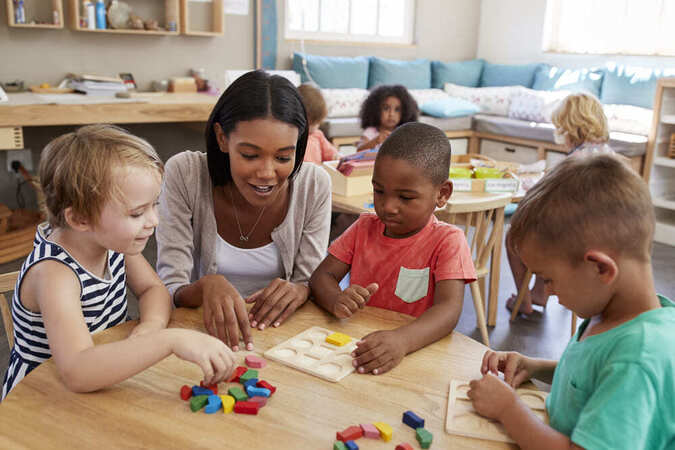Kindergarten is an important stage in a child’s educational journey as it lays the foundation for their future academic and social development. Yet, No Such Thing as a Perfect Kindergarten is a concept that many parents and educators grapple with. Every child is unique, with their own interests, strengths, and goals, making it impossible to create a one-size-fits-all model for kindergarten education and early childhood education.
In this blog, we will talk about why there’s no such thing as a perfect kindergarten that works for every kid. Let’s take a closer look at what makes each kid’s journey in kindergarten unique.
KEY TAKEAWAYS:
- The concept of a perfect kindergarten is unrealistic because every child has unique needs, interests, and learning styles that a one-size-fits-all approach cannot address.
- Play-based learning is an essential component of kindergarten education, as it promotes creativity, imagination, and problem-solving skills while also helping children develop important social and emotional competencies.
- It is important for kindergartens to provide a safe, nurturing, and stimulating environment that encourages exploration, learning, and social interaction.
Understanding the Concept of a Perfect Kindergarten
When it comes to the concept of a perfect kindergarten, it’s important to understand that there is no such thing as a one-size-fits-all solution. Every child has unique needs, interests, and learning styles, which means that what works for one child may not work for another.
The idea of a perfect kindergarten often places the entire responsibility on educators, but it’s important to remember that parents and families also play a crucial role in their children’s education.
Collaboration between educators and families is key to creating an environment that supports children’s growth and development.
While some may strive for an ideal kindergarten that offers a wide range of activities and resources, it’s important to remember that what matters most is creating a supportive and inclusive social environment where children can develop empathy, communication skills, and emotional resilience.
Reasons Why There Is No Such Thing as a Perfect Kindergarten
There are several reasons why there is no such thing as a perfect kindergarten.
1. Diverse Learning Styles
For one, children have diverse learning styles. Some children are visual learners, while others are auditory or kinesthetic learners. A perfect kindergarten teacher would need to cater to all these learning styles, which is practically impossible.
2. Individual Personalities and Needs
Additionally, children have different personalities, strengths, and weaknesses that require different approaches to teaching and learning. While some kids might do well in a busy setting full of friends and activities, others might do better in calmer, more controlled environments.
Despite the challenges, educators are constantly striving to create the best possible kindergarten experience for children. While there may not be a perfect kindergarten, there are certainly ways to create a positive and enriching environment that fosters growth, learning, and development.
KinVibes Pro-Trip: Rather than focusing on an ideal or perfect kindergarten, it’s important to prioritize creating an environment that supports each child’s individual growth and development.
The Role of Play in Kindergarten
Play-based learning is an essential component of a kindergarten curriculum. It is through play that children develop their cognitive, social, emotional, and physical skills. Play allows children to explore, experiment, and learn at their own pace, which is crucial for their development.
Importance of Play-Based Learning
Research has shown that play-based learning has numerous benefits for children. It promotes creativity, imagination, and problem-solving skills. It also helps children develop their language and communication skills, as well as their ability to work collaboratively with others.
Here are numerous advantages of play-based learning. Let’s take a look at each one.
1. Sense of Autonomy
Play-based learning provides children with a sense of autonomy and control over their learning. It allows them to make choices and decisions about what they want to learn and how they want to learn it. This sense of ownership over their learning is essential for building their confidence and motivation.
2. Lifelong Learning
Time for play is also important in kindergarten. Children need time to engage in unstructured play, where they can explore and discover on their own. This type of play allows children to develop their own interests, passions, and curiosities, which can lead to lifelong learning.
3. Develop Skills
Lastly, play-based learning also provides children with the opportunity to learn and grow in a way that is developmentally appropriate and engaging. By promoting play in kindergarten, we can help children develop the skills they need to succeed in school and beyond.
The Kindergarten Environment
In addition to the importance of play-based learning, the environment of the kindergarten also plays a crucial role in a child’s early education. It sets the tone for the rest of the child’s learning experience and can greatly impact their social and emotional development.
Kindergartens should be located in a safe and accessible area, preferably near the child’s home, family’s home, or their parent’s workplace.
For example, having outdoor play areas and natural settings is beneficial, as it allows children to spend time in fresh air, explore their environment, and participate in physical activities. Therefore, kindergartens should have adequate outdoor space and equipment to facilitate this.
Let’s delve into the various aspects of the kindergarten environment and how they contribute to the holistic development of children.
1. Diversity
A diverse student body can expose children to different worlds around cultures, languages, and perspectives, which can help them develop empathy and understanding.
2. Inclusivity
Inclusive environments ensure that all children, regardless of their abilities or backgrounds, have equal access to learning opportunities and resources.
Overall, the kindergarten environment should be designed to foster a love of learning and provide children with a safe and nurturing space to grow and develop.
The Importance of Social Skills

Kindergarten is a crucial time for children to develop necessary skills as they interact with a diverse range of personalities. Good social skills allow kids to interact positively with others and communicate their needs, wants, and feelings effectively. Children with better social skills are likely to reap immediate benefits.
Let’s explore some of the skills that children can begin to develop during their kindergarten years.
Empathy
Kids who can understand and share the feelings of others are more likely to get along with their peers. Encouraging children to put themselves in other people’s shoes can help them develop empathy.
Communication
Communication is another vital social skill. Children need to be able to express themselves clearly and listen actively to others.
Teachers and parents can help children develop communication skills by modeling good communication habits and encouraging children to express their thoughts and feelings.
Respect
Diverse personalities can make it challenging for children to develop social skills. However, it is essential to teach children to appreciate and respect differences in others. Encouraging children to play with children who are different from them can help them develop social skills and empathy.
The Kindergarten Curriculum

Along with developing social skills, the kindergarten curriculum is designed to lay a strong foundation for children’s academic future. The curriculum for kindergarten is designed to help children develop their cognitive, social, and emotional skills.
In addition to reading and writing, kindergarten students also learn about fundamental concepts such as:
- Numbers and shapes
- Basic math concepts like addition and subtraction
- Basic shapes like circles, squares, and triangles
Reading and Writing in Kindergarten
One of the most important aspects of the kindergarten curriculum is teaching children to read and write. Children are also taught to write letters, words, and sentences. Kindergarten teachers use a variety of methods to help children learn to read, including:
- Phonics
- Sight words
- High-frequency words
Learning Numbers and Shapes
Furthermore, the kindergarten curriculum is designed to help children develop the skills they need to succeed in school and life. By teaching children to read, write, and do basic math, kindergarten teachers set the foundation for future academic success.
Teaching Methods
The teaching methods used in kindergarten are designed to be engaging and interactive. Teachers use a variety of strategies to keep children interested and motivated, including:
- Games
- Songs
- Group activities
Here’s a table providing additional examples and benefits to assist teachers and educators in instructing kindergarten students:
| Component | Examples | Benefits |
|---|---|---|
| Reading and Writing | Counting objects, number songs, number games. Combining sets of objects Identifying shapes in the environment, shape sorting activities, drawing shapes. | Counting objects, number songs, number games. Combining sets of objects Identifying shapes in the environment, shape sorting activities, and drawing shapes. |
| Numbers and Shapes | Math puzzles, word games Alphabet song, counting songs Collaborative storytelling, science experiments, and art projects | – Develops mathematical skills. Enhances spatial awareness. Prepares for academic success in mathematics. |
| Teaching Methods | – Improves literacy skills. Enhances creativity and imagination. Prepares for academic success. Develop communication skills. | – Promotes social interaction and teamwork. Enhances memory and cognitive skills. Encourages a love for learning through fun and engaging activities. |
The Role of Kindergarten Teachers

Kindergarten teachers play a crucial role in shaping the learning and development of young children. They are responsible for creating a safe and nurturing environment that encourages children to explore, learn, and grow.
Educators must possess excellent communication skills, empathy, and a range of teaching techniques to create a safe, nurturing, and enjoyable learning environment.
Connecting with Young Minds
Effective communication skills are essential for kindergarten teachers. They need to be able to communicate clearly and effectively with both children and parents. This involves an approach that is easy to understand:
- Active listening
- Asking questions
- Providing feedback
Empathy is another essential trait for kindergarten teachers. They need to be able to understand and relate to the feelings and emotions of young children. As a result, this allows them to create a supportive and caring environment that helps children feel safe and secure.
Facilitating Academic and Social Development
In addition to their academic development, teachers play a pivotal role in cultivating essential social skills in young children. They use various teaching techniques and strategies to engage children and make learning fun. This includes using games, songs, and other interactive activities to help children learn and remember new concepts.
Understanding Different Learning Styles

As kindergarten teachers shape the learning environment, they must also understand and adapt to the diverse learning styles of their students. Teachers need to recognize and accommodate different learning styles in their classrooms to ensure that each child has the opportunity to learn and succeed.
According to Scholastic, learning styles are generally grouped into four categories: sensing, intuitive, feeling, and thinking.
However, it is important to note that the notion of learning styles may be a myth, as there is no scientific evidence to support it, according to research published by the American Psychological Association.
What are the two learning styles?
1. Visual Learners
Visual learners are those who prefer to learn through images, graphs, and other visual aids. They tend to have a better memory for visual information and may struggle with verbal instructions.
But how can teachers assist visual learners? By incorporating visual aids into their lessons, such as:
- Diagrams
- Videos
2. Kinesthetic Learners
Kinesthetic learners are those who prefer to learn through physical activity and hands-on experience. These students tend to have a better memory for experiences and may struggle with traditional lecture-style teaching.
Similarly, for kinesthetic learners, teachers can incorporate activities that involve movement, like:
- Role-playing
- Experiments
The Importance of Independence and Making Mistakes
Independence is an essential skill that children should learn from an early age. It helps them develop self-confidence and self-reliance, which will be useful throughout their lives.
According to a study, recognizing and promoting independence in young children is crucial for their development.
As you can see, parents and educators should encourage children to take on age-appropriate responsibilities and tasks. Giving children a sense of responsibility can help them develop independence and self-esteem.
For example, young children can help with household chores like setting the table or sweeping the floor.
How Parents and Educators Can Accept Imperfections
- Parents should allow their children to experience frustration and disappointment.
- By encouraging independence and allowing them to make mistakes.
- They should encourage children not to be afraid to try new things.
As stated in an article from HealthyChildren.org, “It is futile and self-defeating to try to be perfect or to raise perfect children.”
Holistic Development in Kindergarten
In kindergarten, children are exposed to various learning experiences that promote holistic development. Holistic development refers to the development of the whole child, including their physical, emotional, social, and cognitive development.
One important aspect of holistic development in kindergarten is the development of motor skills. Participating in these activities equips children with essential physical skills that lay the groundwork for a healthy and active lifestyle throughout their lives.
- Gross Motor Skills: Running, jumping, and playing with balls help children develop their gross motor skills
- Fine Motor Skills: Drawing, cutting, and writing help develop their fine motor skills
In addition to physical development, kindergarten also promotes emotional development. Teachers create a safe and supportive classroom environment that encourages children to express their feelings and emotions. This helps children develop emotional intelligence, which is critical for building positive relationships with others.
Social and emotional development is also a key focus in kindergarten. Children learn how to interact with others, share, take turns, and work collaboratively.
In return, children develop empathy and respect for others, which are important skills for building positive relationships and creating a sense of community.
Class Size and Diversity
When it comes to creating a perfect kindergarten, class size and diversity are two important factors to consider in providing the best possible learning environment for all students.
Research findings on the impact of class size on student learning are mixed.
- According to a 2022 article from U.S. News, teacher quality is also key, while reducing class sizes can have benefits.
- A 2013 analysis published in Chalk Beat and Policy Analysis found that children who attended smaller classes in kindergarten through third grade were likelier to graduate from high school and attend college than those who attended larger classes.
- A 2022 article from Edutopia highlights the importance of school diversity, stating that students who attend diverse schools are more likely to develop cross-cultural competencies and better critical thinking skills.
In addition to class size, diversity is also important in creating a successful kindergarten. Children have diverse learning styles, and a perfect kindergarten program would need to cater to all these learning styles, which can be a challenge.
Budget and Location Considerations
When choosing a kindergarten, budget and location are two important factors to consider. A careful balance between budgetary constraints and the ideal location will ensure that parents make the best decision for their child’s early educational experience.
1. Budget and Costing
Some kindergartens may offer scholarships or financial aid to families who cannot afford the full tuition. Parents should inquire about these options and see if they qualify. It is important to note that a higher price tag does not always equate to a better education. Parents should research and compare different kindergartens to find one that fits their budget and offers quality education.
2. Location and Convenience
Location is also an important factor to consider. Parents should choose a kindergarten that is:
- Located in a safe and accessible area
- Commute time and whether it is feasible for them to drop off and pick up their child
- The proximity of the kindergarten to their workplace or home
KinVibes Pro-Tip: It is important to find a kindergarten that offers quality education at a reasonable cost and is located in a safe and convenient area.
Kindergarten Readiness
Preparing a child for kindergarten can be a daunting task, but it is essential for their academic and social development. In addition, transitioning from a childcare center to a kindergarten can be made easier by encouraging children to play with others.
For example, parents and caregivers can use a kindergarten readiness checklist to ensure that their child has the necessary skills to succeed in kindergarten.
The Kindergarten Readiness Checklist
The kindergarten readiness checklist is a tool that parents and caregivers can use to assess their child’s readiness for kindergarten. It includes a list of academic and social skills that children should have before entering kindergarten. Some of the skills on the checklist include:
- Recognizing basic shapes
- Counting to ten
- Following simple instructions
In addition to academic skills, the checklist also includes social and emotional skills such as sharing, taking turns, and following rules. These skills are just as important as academic skills and can help children succeed in the classroom and beyond.
Transitioning from Childcare to Kindergarten
Transitioning from a childcare center to a kindergarten can be a significant change for both children and parents. To help ease the transition, parents can start preparing their children for kindergarten several months in advance.
One way to prepare is by practicing academic skills such as:
- Writing their name
- Recognizing letters and numbers
- Completing simple chores (i.e putting away their toys)
Parents can also help their children develop social and emotional skills by encouraging them to play with other children, take turns, and share.
The Philosophy of Kindergarten Teaching

Kindergarten is a critical time for children’s development, and teachers must have a solid philosophy to guide their teaching. The philosophy of kindergarten teaching is rooted in the belief that respectful, caring bonds with children and their families are the vital foundation for a wonderful kindergarten experience.
In that case, teachers strive to create a supportive and inclusive social environment where children can develop empathy, communication skills, and emotional resilience.
Catering to Individual Needs
Central to kindergarten teaching philosophy is recognizing that each child is unique, possessing their own mix of interests, aptitudes, and goals. Teachers understand that some kids might do well in a busy setting full of friends and activities while others might do better in calmer, more controlled environments. Therefore, teachers work to create a learning environment that caters to the needs of each child.
Promoting Early Literacy
In addition to catering to individual needs, early literacy is also an essential component of kindergarten teaching philosophy.
Teachers use a variety of strategies to help children develop reading and writing skills. They understand that children learn best when they are actively involved in the learning process. Therefore, teachers use these campaign materials to help children develop their literacy skills.
- Hands-on activities
- Games
- Other interactive strategies
Child Development
On the other hand, Philosophy in kindergarten strongly underscores the importance of child development. Recognizing that children thrive in environments that are attuned to their developmental needs, educators meticulously design activities that foster cognitive, social, emotional, and physical growth.
In addition to these activities, teachers use a combination of:
- Positive discipline techniques
- Consistent and dependable routines
- Encouraging and empowering messages
These strategies are integral in nurturing children’s self-discipline, perseverance, and a growth mindset.
They also emphasize child development and use various strategies to help children develop their cognitive, social, emotional, and physical skills.
Final Thoughts – Embrace the Uniqueness of Every Kindergarten JOURNEY
As we’ve explored, the concept of a ‘perfect kindergarten’ is indefinite and, to a large degree, a myth. This is largely because of the beautiful diversity of children – each with their unique learning styles, interests, personalities, and backgrounds.
Instead of aiming for a utopian ‘perfect’ kindergarten, the objective should be to cultivate a nurturing environment that champions the individuality of each child. By fostering collaboration between educators and families, promoting play-based learning, embracing diversity, and supporting holistic development, we can provide the best possible platform for our young minds to flourish.
While it’s true that there may be no such thing as a perfect kindergarten, the impact of a thoughtful gesture towards those who guide our young learners cannot be underestimated. Teachers play a pivotal role in shaping our children’s early education experiences. To express our gratitude and recognize their dedication, crafting the perfect Teacher’s Day letter can be a touching way to show appreciation. If you’re looking for tips and ideas on how to pen down your feelings, don’t miss our article on ‘Crafting the Perfect Teacher’s Day Letter: Tips and Ideas’.






